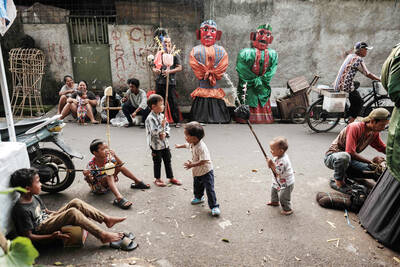Shifting debris and twisted metal by hand, Haitian workers backed by Japanese UN military engineers on Monday rescued remaining valuable paintings and sculptures from the collapsed rubble of one of Haiti’s most notable art museums.
The workers and UN troops were trying to salvage what they could of Haiti’s rich artistic heritage, ravaged by the Jan. 12 earthquake that may have killed up to 300,000 people, the country’s president said.
Port-au-Prince’s Nader Art Museum, which with 12,000 paintings housed probably the world’s most important private collection of Haitian art, was reduced to rubble by the quake, which also badly damaged the presidential palace, the city cathedral and many other historic buildings.
Since the quake struck six weeks ago, gallery staff have been carefully extracting the most important works from the wreckage. Brightly colored canvases, many torn and smeared with dust, are piled to one side, while empty wooden frames are stacked in another pile.
Workers carry away wooden and metal sculptures, some missing arms and legs in a grotesque reflection of the horrific human injuries inflicted by the quake.
Georges Nader Jr, 40, son of museum owner Georges Nader, said the “search and rescue” phase of the museum salvage operation was almost over.
“We’ve been digging for a month ... the hand removal stage is almost over, then heavy machinery will move in,” he said. “But if you put a mechanical digger in there right away, you will lose everything.”
He was philosophical about the loss to the collection.
“I think about 50 percent, with some kind of restoration, will be salvageable,” Nader said.
A separate Nader gallery in Petionville district survived the quake.
About 95 percent of the Haitian masters part of the museum collection, including works by Hector Hyppolite (1894-1948) and Philome Obin (1892-1986), survived because they were housed in a front part of the collapsed building, Nader said.
“Some are not even scratched. We have someone working on restoration, where necessary, right now,” he said.
Asked if the collection was insured,” Nader laughed wryly: “If it was, I wouldn’t be here.”
Of the museum’s sculptures, reflecting the rich African heritage of Haiti, which won independence through an 1804 slave revolt, Nader put losses at between 60 percent and 70 percent.
“When we pulled the sculptures out, some of them had broken arms and legs,” he said.
Japanese UN officers wearing blue caps and helmets and the shoulder patches of Japan’s Central Readiness Regiment, supervised workers and a mechanical digger.
Around 200 Japanese troops are participating in the international relief operation in Haiti, and this number would rise to over 300 next month, Captain Shingo Hayakawa said.
Nader’s father George, 78, who started the collection in 1966, and his mother, both survived the quake.
Nader said he believed much of the Caribbean’s country’s artistic patrimony, including the famed 1950s mural paintings of the Sainte Trinite Cathedral, had been lost.
But amazingly, many of the city’s oldest houses, which are built of wood in the elaborate “gingerbread” Caribbean style, withstood the magnitude 7 quake, while hundreds of more modern concrete, steel and mortar structures crumbled.
“This would a good time to restore the old houses,” Nader said.
France, Haiti’s former colonial master, will draw up a preparatory study for reconstruction of the wrecked presidential palace, and has offered to restore a damaged 1822 painting depicting Haitian independence heroes which was salvaged by a French team from inside the ornate white palace.
In other news, six US-bound orphans seized by Haitian police despite having their papers in order remained in a government-run nursery more than two days later, the orphanage director said.
The seizure of the orphans and the brief detention of their escorts on Saturday came amid fears that foreigners are exploiting the post-quake chaos to illegally take children from the country — a perception fueled by an ongoing case involving 10 US Baptist missionaries.
“The youngest has developed diarrhea and is very dehydrated,” said Jan Bonnema of Prinsburg, Minnesota, founder and director with her husband, Bud, of the Children of The Promise orphanage, where the six children originated.
Bonnema, whose orphanage is located in the northern city of Cap-Haitien, said late on Monday that the children had been bound for the US via Miami, where their adoptive parents were waiting for them.
Police detained the children and the four women escorting them, including the orphanage’s Irish field director and one US adoptive mother, Sarah Thacker of Ferbus Falls, Minnesota, as they were about to depart from Port-au-Prince airport on Saturday, Bonnema said.
“They were just inside the terminal. They hadn’t gone through immigration,” she said in a telephone interview from Minnesota, because they were waiting for US embassy staff to come with adoption papers signed by Haiti’s prime minister.
US Senator Amy Klobuchar of Minnesota has intervened on behalf of the women. She told The Associated Press that the orphanage is legitimate and said the adopting families in Minnesota have been working with her office.

In the sweltering streets of Jakarta, buskers carry towering, hollow puppets and pass around a bucket for donations. Now, they fear becoming outlaws. City authorities said they would crack down on use of the sacred ondel-ondel puppets, which can stand as tall as a truck, and they are drafting legislation to remove what they view as a street nuisance. Performances featuring the puppets — originally used by Jakarta’s Betawi people to ward off evil spirits — would be allowed only at set events. The ban could leave many ondel-ondel buskers in Jakarta jobless. “I am confused and anxious. I fear getting raided or even

Eleven people, including a former minister, were arrested in Serbia on Friday over a train station disaster in which 16 people died. The concrete canopy of the newly renovated station in the northern city of Novi Sad collapsed on Nov. 1, 2024 in a disaster widely blamed on corruption and poor oversight. It sparked a wave of student-led protests and led to the resignation of then-Serbian prime minister Milos Vucevic and the fall of his government. The public prosecutor’s office in Novi Sad opened an investigation into the accident and deaths. In February, the public prosecutor’s office for organized crime opened another probe into

RISING RACISM: A Japanese group called on China to assure safety in the country, while the Chinese embassy in Tokyo urged action against a ‘surge in xenophobia’ A Japanese woman living in China was attacked and injured by a man in a subway station in Suzhou, China, Japanese media said, hours after two Chinese men were seriously injured in violence in Tokyo. The attacks on Thursday raised concern about xenophobic sentiment in China and Japan that have been blamed for assaults in both countries. It was the third attack involving Japanese living in China since last year. In the two previous cases in China, Chinese authorities have insisted they were isolated incidents. Japanese broadcaster NHK did not identify the woman injured in Suzhou by name, but, citing the Japanese

RESTRUCTURE: Myanmar’s military has ended emergency rule and announced plans for elections in December, but critics said the move aims to entrench junta control Myanmar’s military government announced on Thursday that it was ending the state of emergency declared after it seized power in 2021 and would restructure administrative bodies to prepare for the new election at the end of the year. However, the polls planned for an unspecified date in December face serious obstacles, including a civil war raging over most of the country and pledges by opponents of the military rule to derail the election because they believe it can be neither free nor fair. Under the restructuring, Myanmar’s junta chief Min Aung Hlaing is giving up two posts, but would stay at the